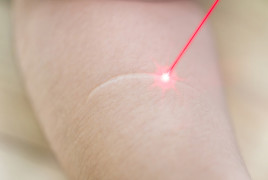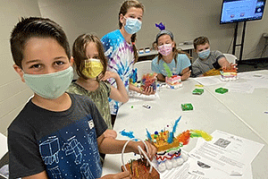Prurigo nodularis: Diagnosis and treatment
How do dermatologists diagnose prurigo nodularis?
Your dermatologist can often diagnose prurigo nodularis by examining your skin for signs of this skin condition, such as itchy bumps and patches.
When examining your skin, your dermatologist will look closely to see if you might have another skin condition. Many people develop an itchy skin condition before they get prurigo nodularis.
If it looks like you have more than one skin condition, your dermatologist may need to scrape off a bit of skin or perform a skin biopsy. The skin your dermatologist removes will be examined under a microscope. This close-up view helps your dermatologist give you an accurate diagnosis.
Both the scraping and skin biopsy can be performed during your appointment while you remain awake. A scraping is exactly what it sounds like. Your dermatologist scrapes off a bit of skin. During a skin biopsy, your dermatologist numbs the area and then removes a small amount of skin.
During your appointment, your dermatologist will also ask questions. This helps them learn how the itch and bumps affect your life, whether you may have another condition, and important information that can affect your treatment plan.
Because people who develop prurigo nodularis may have another disease, including diabetes, hepatitis C, or untreated HIV, you may need blood tests.
If you have prurigo nodularis, your dermatologist will create a treatment plan tailored to your needs.
Prurigo nodularis may be the first noticeable sign of another disease like lymphoma or untreated HIV
That’s why dermatologists give patients who have prurigo nodularis a thorough exam, order medical tests, and sometimes refer a patient to another medical doctor.

How do dermatologists treat prurigo nodularis?
When treating prurigo nodularis, the goals are to:
Give you relief from the itch.
Clear bumps and patches.
Reduce the amount of sleep you lose to symptoms like itch.
Improve your overall quality of life.
To treat prurigo nodularis, your dermatologist will create an individualized treatment plan, which may include one or more of the following:
Skin care plan: The right skin care can reduce how much you scratch. The less you scratch, the fewer bumps you’ll have. Your skin care plan may include:
Anti-itch cream: Applied to the skin, this can reduce the urge to scratch. This treatment can also help to soften and flatten the bumps and patches.
Medication applied to the skin: This is often part of the treatment plan. Topical (applied to the skin) medications include the following:
Itch relief medication (non-prescription): Your dermatologist may recommend applying menthol, phenol, pramoxine, or capsaicin cream to help relieve the itch. Because these are available without a prescription, you can buy them at a store or online.
You apply this medication as directed by your dermatologist. For example, when treating prurigo nodularis, patients often apply capsaicin cream 4 to 6 times a day for 2 weeks and sometimes longer.
Tell your dermatologist if you have trouble applying the medication as directed or develop side effects like irritated skin.Corticosteroid: If you have a few bumps on your skin, this can be an effective treatment. This medication works to reduce inflammation, which can decrease how much your skin itches.
You apply this medication at home as directed. For example, your dermatologist may tell you to apply it before bed and cover the area with plastic. You may do this for 2 to 4 weeks. Some patients need to apply the medication for a longer time. Other patients apply the corticosteroid twice a day but don’t cover it.
You gradually decrease the amount that you use.
Possible common side effects include dry, irritated skin and a burning sensation when you apply the medication. The burning goes away quickly.Medical tape coated with a corticosteroid: This treatment can reduce the itch and flatten bumps and patches. It also puts a protective layer between your nails and your skin, so you cannot directly scratch the bumps and patches. The tape also helps your skin absorb more of the medication.
Possible common side effects are the same as for the corticosteroid you apply to your skin. They include dry, irritated skin and a burning sensation when applied.Pimecrolimus or tacrolimus: If a corticosteroid is not right for you, your dermatologist may prescribe one of these medications. Also known as topical calcineurin inhibitors, these medications can significantly reduce the itch, which allows your skin to heal.
You apply this medication as directed, often twice a day.
Possible side effects include irritated skin and a burning sensation for a few days.Brand names: Elidel (pimecrolimus cream), Protopic (tacrolimus ointment)
Calcipotriol: If you need a stronger medication, your dermatologist may prescribe this. It’s a synthetic form of vitamin D that can reduce the size of the bumps on your skin.
You apply this medication as directed, usually once or twice a day.
Possible side effects include dry, irritated skin, a burning sensation where you apply the medication, and sensitivity to sunlight.Brand names: Dovonex, Calcitrene, Sorilux, Calsodore, Kalosar
Medication containing ketamine, amitriptyline, and lidocaine: This treatment is made by a compounding pharmacy. It combines these 3 medications and may be prescribed if other treatments fail to bring relief. Combining all 3 medications into one enhances the effects of each, which can reduce pain and itching.
You apply this medication to the skin with prurigo nodularis as directed by your dermatologist.
To ensure that you get the right dose of each medication, it’s essential that your prescription be made by a licensed compounding pharmacy. Your dermatologist will recommend one and watch you carefully while you use this treatment.
Possible side effects include irritated skin and a burning sensation where you apply the medication. While rare, this medication can cause dizziness and make you sleepy.
Procedure: Your dermatologist may include a procedure (treatment performed during an office visit) if you have one or a few bumps that:
Are especially painful, itchy, or thick
Didn’t clear with another treatment
Need help to speed up clearing
Two procedures that dermatologists use to treat prurigo nodularis are:
Corticosteroid (injections): If you have a bump, patch, or intense itching that isn’t going away with treatment, your dermatologist may inject the area with a corticosteroid. These injections can quickly relieve the itch and flatten the bump or raised patch.
Injections are usually given every 4 to 6 weeks until the itch or bump goes away.
Possible side effects where the medication is injected include temporary soreness or bruising and a lighter color on your skin (hypopigmentation).Cryosurgery: If prurigo nodularis fails to go away with other treatments, your dermatologist may talk with you about cryosurgery. This procedure can effectively relieve the itch and pain when other treatments fail.
During cryosurgery, you remain awake the entire time while your dermatologist applies a very cold substance like liquid nitrogen to the bumps and patches. Freezing helps to reduce the itch and flatten the lesions.
When cryosurgery is used to treat prurigo nodularis, most patients need between 2 and 4 treatments. After each cryosurgery treatment, you may see crusting or a blister on your treated skin. This is normal and expected.
Cryosurgery is seldom a treatment for people with darker skin tones. On darker skin, it can cause noticeable light spots, scarring, or both.
Phototherapy (also known as light therapy): Studies have shown that this type of treatment can effectively treat prurigo nodularis. Your dermatologist may prescribe phototherapy if you need stronger treatment than you can get from applying medications to your skin — or you have bumps and plaques on large areas of your skin.
Phototherapy is typically prescribed by a dermatologist
This non-invasive treatment exposes you to a prescribed amount of ultraviolet (UV) light for a precise amount of time.

There are different types of phototherapy. Many patients go to a phototherapy treatment center and stand in a light box for a prescribed amount of time. If this is part of your treatment plan, you would go to your dermatologist’s office or phototherapy treatment center 2 to 3 times per week for a number of weeks.
Another type of phototherapy involves getting excimer laser treatments. For some patients, this laser can effectively treat a stubborn bump or patch of prurigo nodularis that just won’t go away. Research shows that it can work when other treatments fail.
For both types of phototherapy, you need a series of treatments. Should you find it difficult to keep your appointments, tell your dermatologist. Don’t try tanning beds, sunlamps, or sitting in the sun. If you get overheated or sunburned, you can have a flare-up. You can also damage your skin and increase your risk of developing skin cancer.
Possible side effects from phototherapy include skin discoloration, swelling, skin darkening where treated (hyperpigmentation), or blisters. When a dermatologist prescribes phototherapy, these are rare.
Medication that works throughout the body
Research breakthroughs have led to FDA-approved medications that are giving patients significant relief from the itch and reducing the number of bumps on their skin. This, in turn, is improving life for many people who were living with long-lasting itching, bumps, and pain. Other medications that work throughout the body may also be prescribed.
Medications that work throughout the body include:
Dupilumab: This medication is FDA approved to treat adults who have prurigo nodularis. Dupilumab works by reducing inflammation thought to cause itchy skin. It can effectively reduce the itch and clear lesions on the skin when other treatments fail. For many patients, itch relief happens quickly.
This medication is given as an injection just beneath the skin. You will be taught how to inject this medication, so you can treat yourself at home. The first dose consists of 2 injections. After that, you inject yourself every other week. You can get this medication in a pre-filled syringe or self-injector pen.
In the studies that led to FDA approval of dupilumab for prurigo nodularis, the most common side effects were mild. They included inflamed (red and itchy) eyes and eyelids, cold symptoms like a stuffy nose, and diarrhea.Brand name: Dupixent
Nemolizumab: This medication is FDA approved to treat adults who have prurigo nodularis. It can stop the itch-scratch cycle.
In studies, nemolizumab has significantly reduced the itch within 48 hours. It has also reduced the bumps and patches — and sometimes completely cleared the skin.
Nemolizumab comes in a prefilled self-injector pen. If this medication is prescribed, you would receive an initial dose. After learning how to inject it, you would give yourself another dose once every 4 weeks.
The most common possible side effects are headache and developing atopic dermatitis or nummular dermatitis (both types of eczema).Brand name: Nemluvio
Antihistamine for nighttime itch: Some antihistamines make you drowsy. Taking one of these at bedtime may prevent itching, so you can sleep.
Buying this medication doesn’t require a prescription. Your dermatologist will explain which antihistamine(s) to take and how to take it.
Possible side effects when taking this medication to control the itch of prurigo nodularis include dry mouth and throat, dizziness, and constipation. Staying hydrated can help with dryness and, possibly, constipation.Methotrexate or cyclosporine: These medications have been prescribed for years to treat prurigo nodularis when other treatments fail to work. They are used less often today due to new FDA-approved treatments for prurigo nodularis.
Methotrexate is a powerful medication used to treat certain types of cancer, severe psoriasis, and other conditions. When treating prurigo nodularis, this medication can bring significant relief from the itch and heal the skin. Possible side effects include nausea, high blood pressure, and liver damage.
Cyclosporine can rapidly reduce the itch. However, it cannot be taken for long due to possible side effects, which include high blood pressure and high creatine levels. The latter can lead to a kidney infection and kidney failure.
If cyclosporine is prescribed, your dermatologist will monitor your blood pressure. You’ll also need blood tests to watch for conditions, including problems with your kidneys or liver. Both medications are pills. You take the pills as directed by your dermatologist.Brand names: Trexall (methotrexate), Gengraf, Neoral (cyclosporine)
Help dealing with anxiety, depression, and other feelings
Having prurigo nodularis can be tough. Some people say that the frequent itch and scratching can take an emotional toll on their lives. They may feel less confident, stop getting together with people, or miss time from work or school.
Getting psychological counseling can be helpful if this disease is taking an emotional toll.
Self-care is an essential part of treating prurigo nodularis
To help their patients get the best results from treatment and start to feel better, dermatologists give their patients self-care tips. You’ll find these tips at: Prurigo nodularis: 9 dermatologists’ tips for relieving the itch.
Images
Getty Images
References
Chao, TJ. “A rapidly changing landscape in prurigo nodularis signals new directions and opportunities for treatment.” Dermatol Times 12/23/2024.
Elmariah S, Kim B, et al. “Practical approaches for diagnosis and management of prurigo nodularis: United States expert panel consensus.” J Am Acad Dermatol. 2021;84(3):747-60.
Huang AH, Williams KA, et al. “Prurigo nodularis: Epidemiology and clinical features.” J Am Acad Dermatol. 2020;83(6):1559-65.
LeCourt AP, “Prurigo nodularis.” In: Medscape (Elston DM., Ed.) Last updated 8/27/2025. Last accessed 1/17/2025.
Legat FJ, Weisshaar E, et al. “Pruritus and dysesthesia.” In: Bolognia JL, et al. Dermatology. (4th edition). Mosby Elsevier, China, 2018: 115-6.
Leis M, Fleming P, et al. “Prurigo nodularis: Review and emerging treatments.” Skin Therapy Lett. 2021;26(3):5-8.
Package inserts: Dupilumab (revised 9/2022), nemolizumab (revised 8/2024). Last accessed 1/17/2025.
Qureshi AA, Abate LE, et al. “A systematic review of evidence-based treatments for prurigo nodularis.” J Am Acad Dermatol. 2019;80(3):756-64.
Ständer S, Schürmeyer-Horst F, et al. “Treatment of pruritic diseases with topical calcineurin inhibitors.” Ther Clin Risk Manag. 2006 Jun;2(2):213-8.
Watsky K (author), Fowler J (section editor). “Prurigo nodularis.” UpToDate. Last updated August 21, 2024. Last accessed January 15, 2025.
Williams KA, Huang AH, et al. “Prurigo nodularis: Pathogenesis and management.” J Am Acad Dermatol. 2020;83(6):1567-75.
Yosipovitch G. “Prurigo nodularis: New treatments on the horizon.” J Am Acad Dermatol. 2020;82(4):1035-6.
Written by:
Paula Ludmann, MS
Reviewed by:
Brendan Camp, MD, FAAD
Raj Chovatiya, MD, PhD, FAAD
Brian Kim, MD, FAAD
Ata Moshiri, MD, FAAD
Carla Torres-Zegarra, MD, FAAD
Last updated: 4/1/25
 Atopic dermatitis: More FDA-approved treatments
Atopic dermatitis: More FDA-approved treatments
 Biosimilars: 14 FAQs
Biosimilars: 14 FAQs
 How to trim your nails
How to trim your nails
 Relieve uncontrollably itchy skin
Relieve uncontrollably itchy skin
 Fade dark spots
Fade dark spots
 Untreatable razor bumps or acne?
Untreatable razor bumps or acne?
 Tattoo removal
Tattoo removal
 Scar treatment
Scar treatment
 Free materials to help raise skin cancer awareness
Free materials to help raise skin cancer awareness
 Dermatologist-approved lesson plans, activities you can use
Dermatologist-approved lesson plans, activities you can use
 Find a Dermatologist
Find a Dermatologist
 What is a dermatologist?
What is a dermatologist?